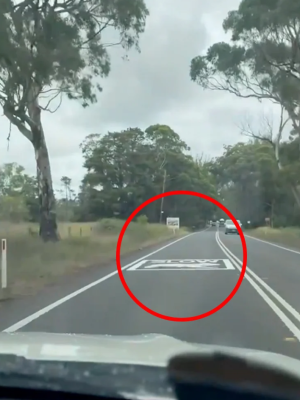Avoid danger zone: Uncover changes on this notorious Aussie road!
By
Gian T
- Replies 4
Australians take pride in their unique wildlife, but some iconic species face growing threats.
In one region, a stretch of road has become infamous for its impact on local animals.
However, new developments hint at possible change—though questions remain. Conservationists are watching closely to see if these efforts will make a real difference.
Drivers along the 10km stretch of Appin Road, known for its high incidence of wildlife collisions, have been greeted by an unusual sight this week.
Bright white safety warnings, featuring an outline of a koala and the word 'slow' emblazoned beneath, have been painted across the bitumen in six known koala hotspots, with a seventh marking in progress.
According to a Transport for NSW spokesperson, these efforts were made in consultation with key ecological experts and WIRES, aiming to alert drivers to the presence of active koala colonies.
'The locations for the road markings were determined in consultation with key ecological experts, WIRES and meet a standard criteria for state controlled roads,' they said.
'The white against black provides maximum contrast to better warn drivers of active koala colonies in the area.'
'Transport will monitor the effectiveness of the new markings on Appin Road.'
The stark white against black asphalt is designed to provide maximum contrast, but the question remains: Will these markings be enough to change driver behavior and protect our vulnerable koalas?
The Total Environment Centre has expressed scepticism, pointing to government advice that current signage has a marginal to ineffective impact on driver speed in areas populated by koalas.
Locals, too, have voiced their concerns. One woman, documenting her drive over the new markings, called them an 'epic fail,' arguing that at 80km/h, drivers don't have enough time to react to the warnings.
Despite these doubts, the NSW government is implementing new road safety measures.
One-way koala escape doors are set to be installed near Gilead, with more to follow across southwest Sydney.
Additionally, an artificial intelligence trial is in the works. The goal is to integrate this technology into 'smart' roadside signage that could alert drivers to the presence of koalas, wombats, and kangaroos.
In a novel approach, a second trial is set to commence in April. It will test whether lighter pavement surfaces can aid drivers in spotting wildlife, especially at night.
This trial, the first of its kind in Australia to assess the effectiveness of light-colored pavement as a wildlife mitigation measure, will take place at Transport’s Future Mobility Testing and Research Centre in Cudal.
'A trial of light-coloured pavement marking will be conducted at FMTRC in Cudal to explore whether increasing road surface contrast can enhance the visibility of wildlife, particularly at night,' a spokesperson said.
'While light-coloured road treatments have been used in Australia for heat reduction, this will be the first trial assessing their effectiveness as a wildlife mitigation measure.'
'The study will test whether the pale pavement improves driver awareness of animals by providing greater contrast against the road surface, potentially reducing wildlife-vehicle collisions.'
The Cumberland Plain region's koala population is critical in the fight against species extinction.
Alarmingly, a recent outbreak of chlamydia, a disease that causes sterility and death, was detected in what was believed to be one of the last disease-free koala populations.
Since the start of the exclusion fencing work, there has been a slight decrease in koala casualties, but the numbers remain distressingly high.
Our readers, particularly those in southwest Sydney, are urged to be vigilant when driving along Appin Road.
The new markings are a step, but only time will tell if they are a stride or a stumble in the effort to protect our koalas.

Have you noticed a difference? Do you believe more should be done? Your voice is crucial in the ongoing dialogue to safeguard our wildlife. Feel free to share your thoughts and opinions in the comments below.
In one region, a stretch of road has become infamous for its impact on local animals.
However, new developments hint at possible change—though questions remain. Conservationists are watching closely to see if these efforts will make a real difference.
Drivers along the 10km stretch of Appin Road, known for its high incidence of wildlife collisions, have been greeted by an unusual sight this week.
Bright white safety warnings, featuring an outline of a koala and the word 'slow' emblazoned beneath, have been painted across the bitumen in six known koala hotspots, with a seventh marking in progress.
According to a Transport for NSW spokesperson, these efforts were made in consultation with key ecological experts and WIRES, aiming to alert drivers to the presence of active koala colonies.
'The locations for the road markings were determined in consultation with key ecological experts, WIRES and meet a standard criteria for state controlled roads,' they said.
'The white against black provides maximum contrast to better warn drivers of active koala colonies in the area.'
'Transport will monitor the effectiveness of the new markings on Appin Road.'
The stark white against black asphalt is designed to provide maximum contrast, but the question remains: Will these markings be enough to change driver behavior and protect our vulnerable koalas?
The Total Environment Centre has expressed scepticism, pointing to government advice that current signage has a marginal to ineffective impact on driver speed in areas populated by koalas.
Locals, too, have voiced their concerns. One woman, documenting her drive over the new markings, called them an 'epic fail,' arguing that at 80km/h, drivers don't have enough time to react to the warnings.
Despite these doubts, the NSW government is implementing new road safety measures.
One-way koala escape doors are set to be installed near Gilead, with more to follow across southwest Sydney.
Additionally, an artificial intelligence trial is in the works. The goal is to integrate this technology into 'smart' roadside signage that could alert drivers to the presence of koalas, wombats, and kangaroos.
In a novel approach, a second trial is set to commence in April. It will test whether lighter pavement surfaces can aid drivers in spotting wildlife, especially at night.
This trial, the first of its kind in Australia to assess the effectiveness of light-colored pavement as a wildlife mitigation measure, will take place at Transport’s Future Mobility Testing and Research Centre in Cudal.
'A trial of light-coloured pavement marking will be conducted at FMTRC in Cudal to explore whether increasing road surface contrast can enhance the visibility of wildlife, particularly at night,' a spokesperson said.
'While light-coloured road treatments have been used in Australia for heat reduction, this will be the first trial assessing their effectiveness as a wildlife mitigation measure.'
'The study will test whether the pale pavement improves driver awareness of animals by providing greater contrast against the road surface, potentially reducing wildlife-vehicle collisions.'
The Cumberland Plain region's koala population is critical in the fight against species extinction.
Alarmingly, a recent outbreak of chlamydia, a disease that causes sterility and death, was detected in what was believed to be one of the last disease-free koala populations.
Infrastructure developments have also posed significant threats. In 2024, trees that once provided safety for koalas along Appin Road were cleared to make way for a new housing project, necessitating the construction of exclusion fencing and concrete underpasses for safe animal crossings.Since the start of the exclusion fencing work, there has been a slight decrease in koala casualties, but the numbers remain distressingly high.
Our readers, particularly those in southwest Sydney, are urged to be vigilant when driving along Appin Road.
The new markings are a step, but only time will tell if they are a stride or a stumble in the effort to protect our koalas.
Key Takeaways
- New safety warnings featuring koala silhouettes and 'slow' signs have been painted on Appin Road, a dangerous stretch known for wildlife fatalities.
- Despite these measures, there is scepticism regarding their effectiveness, with some believing that signage is generally ineffective at slowing down drivers.
- Other safety initiatives are being implemented, including one-way koala escape doors, artificial intelligence trials for ‘smart’ roadside signage, and lighter pavement surfaces to improve wildlife visibility.
- Appin Road's upgrade, including removing trees for construction and installing koala exclusion fencing, has been controversial, and recent data shows the number of koalas hit has increased despite ongoing efforts to reduce fatalities.








